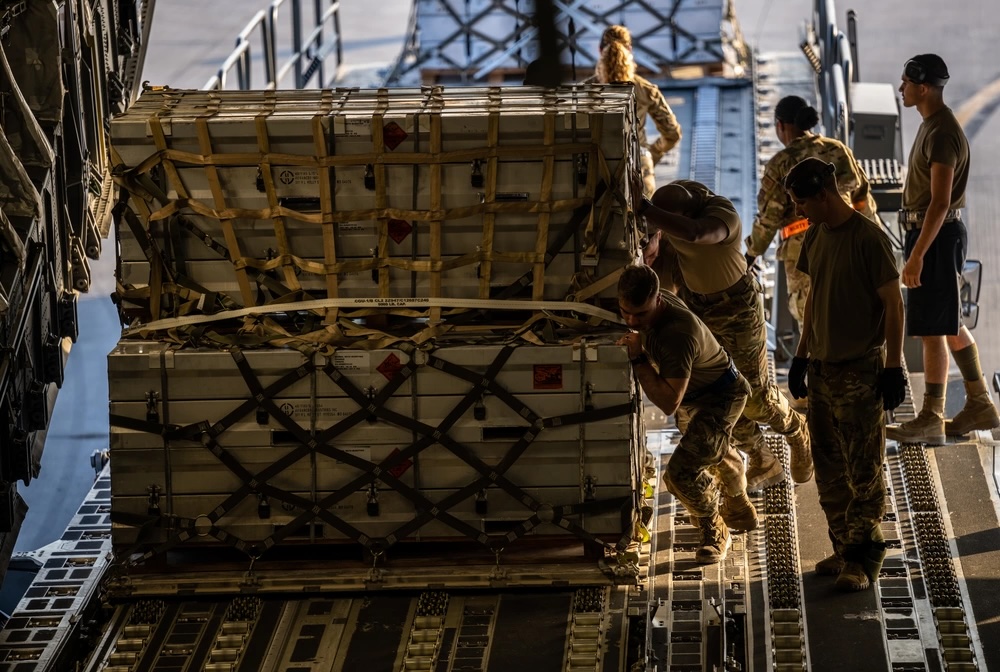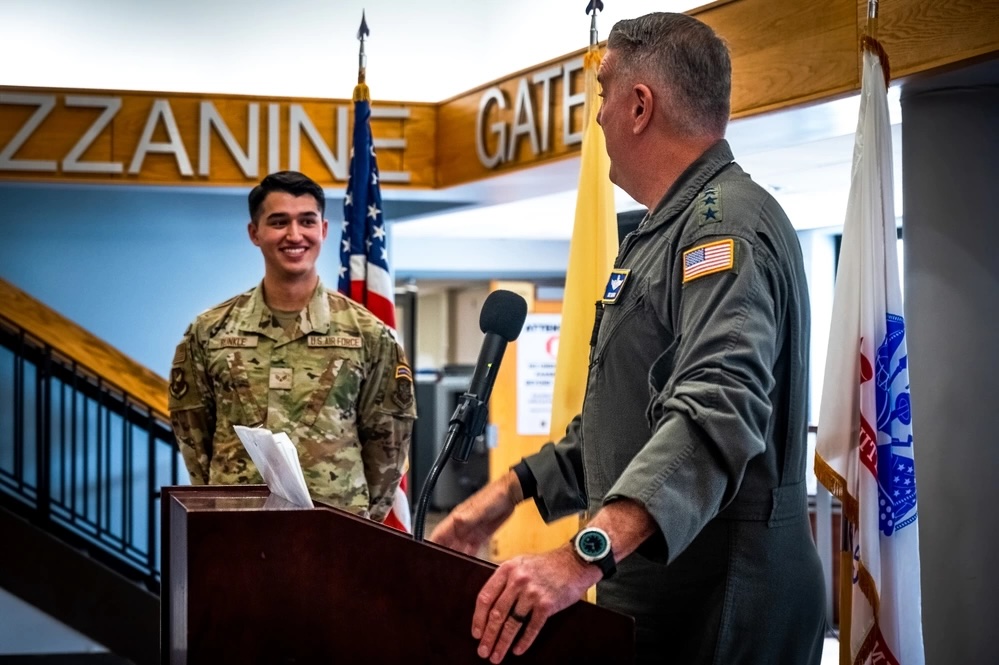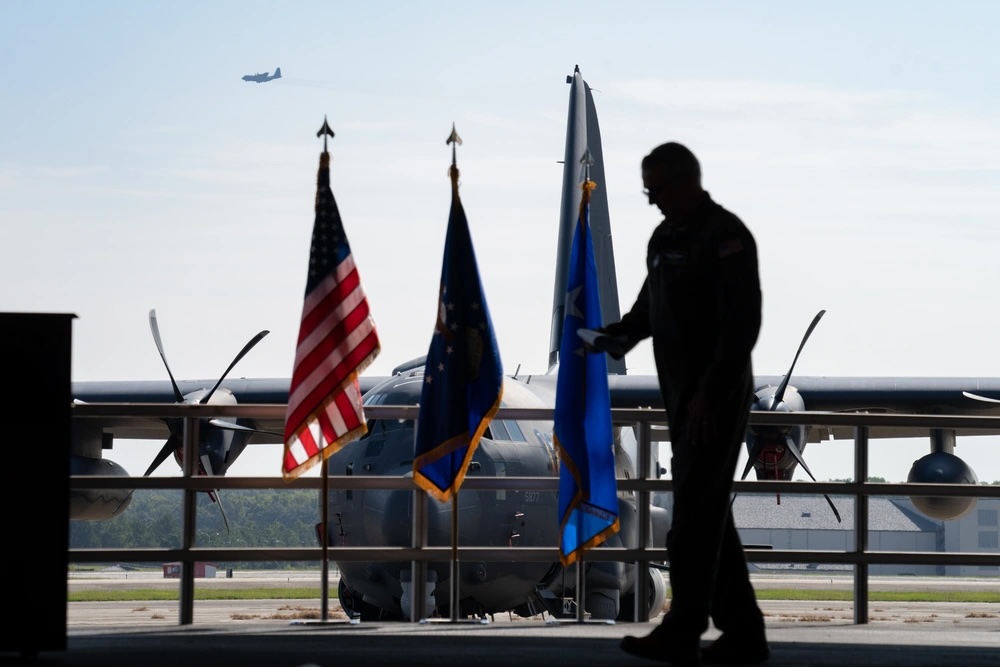Sept. 9 marked the end of an era as Gen. Mike Minihan, the head of Air Mobility Command, retired after a 34-year career and passed the baton to Gen. John D. Lamontagne at a ceremony at Scott Air Force Base, Ill.
During his tenure, Minihan oversaw some of the most demanding periods in AMC history. The command’s 107,000 troops and 1,100 aircraft responded to Russia’s full-scale invasion of Ukraine and Israel’s invasion of Gaza; moved U.S. troops out of Niger; delivered aid to a series of humanitarian crises, and put on Mobility Guardian 2023, a massive exercise where 70 aircraft, 3,000 personnel, and several international partners practiced moving troops and supplies across the Pacific for two weeks.
Mobility Guardian was just one part of a wider effort across the Air Force to prepare for possible future conflict against a near-peer rival such as Russia or China. Elsewhere, mobility troops are flying longer sorties than ever to prepare for the vast reaches of the Pacific and working in smaller teams than ever so they can quickly avoid incoming missile strikes.
It’s a lot to juggle, which is why Minihan wishes he could give mobility Airmen an easier way to handle it all.
“The reality is, we have to find ways that can handle both the tyranny of the urgent and also plan for the future,” he said. “So if I had one gift that I could give to the Airmen of Air Mobility Command, it would be predictability. We have to, with all of that, still provide, to the best we can, predictability so their professional and personal lives are not continually in a state of chaos.”

Every three minutes around the clock, a mobility aircraft takes off or lands after refueling fighters, hauling supplies for a humanitarian relief effort, or a wide range of other missions. That tempo picks up in response to crises, and with only so many aircraft and crews available, AMC is sometimes referred to as “Another Missed Christmas.”
“When we surge, we have to provide an opposite recovery time so that what was lost can be gained back, but also we don’t lose what should have been done,” he said. “So we have to really proactively drive the recovery for the Guard, Active-Duty, Reserve when it comes to the surges that they do routinely.”
Other generals have raised similar concerns. Earlier this year, Maj. Gen. Corey J. Martin, then-head of the 18th Air Force, the only Numbered Air Force under AMC, said mobility Airmen may need their own version of the Air Force Force Generation deployment schedule (AFFORGEN), a two-year cycle made up of four phases: prepare, certify, deploy, and reset, each of which lasts six months.
“Our Airmen don’t necessarily have the luxury of having a six-month reset in the traditional sense that it was designed,” Martin told Air & Space Forces Magazine.
Warrior Heart
In the meantime, Minihan strived to make it easier for Airmen to handle life stress through “Warrior Heart,” an effort to give equal attention and priority to mind, body, and craft by eliminating the stigma surrounding mental health treatment, lowering barriers to treatment, and increasing access and options.
The general pointed out Joint Base McGuire-Dix-Lakehurst, which in July 2023 launched a program called Sean’s Room, where service members can walk into a room at the 305th Air Mobility Wing’s Passenger Terminal and get confidential, informal peer support from trained volunteer Airmen.
The idea lines up with what then-Chief Master Sergeant of the Air Force JoAnne Bass said in February: only two out of every 10 Airmen who seek mental health need clinical support, according to mental health providers. “The other eight just need to know someone cares,” she said.
“There is a shortage of mental health providers, but there is not a shortage of leaders and wingmen,” Bass added.

By October, Sean’s Room had already helped more than 500 guests and saved nine lives, according to Senior Airman Connor Runkle, a C-17 crew chief who played a key role standing up the program along with 305th AMW commander Col. Elizabeth Hanson.
“These individuals received the help and support they needed because we were there to answer their calls,” Runkle said in a press release last year.
Minihan wants mobility wings to have the resources they need to pursue those kinds of ideas.
“We need to be the headquarters that supplies those tools,” he said. “I think we’ve made enormous progress. At the same time, I know we’ve got a lot more to do.”
Starting From Further Behind
Resource issues extend beyond mental health. After Mobility Guardian, Minihan set a goal to outfit 25 percent of the mobility enterprise with connectivity upgrades by 2025. Airmen say secure, beyond-line-of-sight communication—a capability enjoyed by fighter and bomber pilots for decades—is crucial for them to fly the rest of the joint force across the Pacific in a near-peer conflict. But progress has been slow, and reaching the goal by 2025 is very much in doubt.
“There is absolutely a way that we can still get there,” he said. “However, it’s in jeopardy unless we get some infusion of resourcing earlier.”
The technology to provide that connectivity exists. When asked what might be getting in the way, Minihan pointed to the Air Force-wide resourcing problem, the fact that AMC is starting from further behind than other major commands, and the unnecessary bureaucracy that former Chief of Staff Gen. Charles Q. Brown Jr. criticized in his “Accelerate Change or Lose” strategy.
“I think my frustrations are similar to what Gen. Brown laid out,” Minihan said. “The bureaucracy is always a challenge, especially when it comes to developing new technology or instituting technology that already exists.”
In speeches and memos, Minihan made strong statements about the urgency of preparing for near-peer conflict, which experts say will be far more bloody than any Americans have seen for generations. The statements were too strong, some argued—in 2023, the Pentagon distanced itself from a memo in which Minihan predicted a war with China in 2025 and encouraged his Airmen to get to the shooting range and “aim for the head.”
What was his strategy? The general said it was to be clear and concise on the things that he as AMC boss felt needed urgent action.
“I’ve been consistent throughout my whole career in my approach towards commanding and putting a team on the field that’s ready to dominate and win,” he said.
That, and his experience as deputy commander for U.S. Indo-Pacific Command, was why he was promoted to be AMC boss in October 2021, he said.
“I was also told by Gen. Brown, the morning he promoted me and we did the change of command, to go faster,” he said. “I felt a sense of urgency and action from the get-go. I use tools to help define what that urgency and action would look like, and that urgency and action that was delivered by those tools has been extremely successful.
“I am not the least bit concerned about the legacy of Mike Minihan,” he added. “I am consumed with the legacy for Air Mobility Command and its total force Airmen, civilians, families, retirees, everybody that wore the AMC patch past, present, and future.”

The general’s own future lies in Florida, where he will move to help take care of his parents, explore doing nonprofit work, and be available for service members who want advice.
“I have not been able to control my personal tempo for decades,” he said. “I’m looking forward to learning the civilian side of Mike Minihan, and I’m looking forward to spending incredible amounts of time with my family.”
Now it’s up to Gen. Lamontagne to keep building the momentum for what Minihan calls “the most relied-upon force in the history of warfare.”
“Mobility Airmen understand that their efforts … deliver the peace, prosperity, and prestige every day that not just this nation deserves, but the free world deserves,” he said. “We’ve got to do everything in our power to make sure that they have the tools necessary to be successful.”


